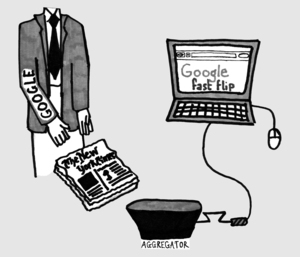Time for newspapers to swallow pride
Many diehard print journalists simply cannot stand online news aggregators. Wall Street Journal editor Robert Thomson called them “parasites or tech tapeworms in the intestines of the Internet.” So it should come as no surprise that the Google Fast Flip, the newest online aggregator, has taken a lot of flak in its first week.
Google Fast Flip, which currently has its experimental site running through Google Labs, aggregates news articles from 36 publishers so far and simulates a print magazine — hence the “flipping.”
Users are greeted with an organized frenzy of newspaper or magazine screenshots at the homepage. Click on a screenshot, and it will maximize the image. Using the left and right arrows, you can “flip” through the pages of the virtual magazine until you find an article you like. Click on that image, and it takes you to the full article at the original site.
The site’s main caché is that the pages really do load and flip quickly, despite being media-rich — assuming you have a fast Internet connection. It’s a fairly impressive attempt at translating a news magazine to the virtual realm.
But there are several drawbacks to Fast Flip. With rows of screenshots lining your computer screen, it initially looks a bit suffocating. Furthermore, you can’t really read the headlines of each article clearly in the minimized screenshots. Then again, navigate to The Los Angeles Times or The New York Times page and the beauty of visual search comes to light. For example, the LA Times has subheads running amok alongside images and bulky, irrelevant advertisements, whereas Fast Flip has neat rows of identically sized screenshots from which to choose and trimmed, content-based advertisements running vertically along the sides.
Naturally, print journalists have raised an outcry about the dangers of news aggregators like Fast Flip. It takes readers away from print media, robbing publishers of a chunk of their revenue. But perhaps most disturbing is that Fast Flip and other virtual search engines imitate the style and, in a way, the interface of print journalism. In their view, it may endanger the future of print journalism as a whole by imitating, and perhaps eventually cannibalizing, the industry.
Yet Google claims this initiative is an attempt to help newspapers attract a larger audience and more creatively engage readers in the news. It hopes to bridge the gap between print and online media and even offer publishers an additional income stream (to make up for the revenue lost from print sales). Google splits its advertisement takings with the publishers, forming a partnership of sorts.
But Google must have its own agenda as well. This is business, and Google has found a window of opportunity that it should take advantage of. Launching Fast Flip will help monetize online content and cement Google as the premiere news aggregator on the web.
Diehard journalists should just accept that consumers — whether young adults or baby boomers — have already embraced technology. It was only a matter of time before print journalism fully jumped on the bandwagon. It’s not as if print journalism has remained stagnant for the past decade — newspapers’ online archives of news articles testify to this fact.
Publishers and journalists should have greater foresight and accept that, in essence, consumers are attracted to visually accessible sites. The average online user is already bombarded by a myriad of images every day, but he would still prefer images over plain words. This transition to visual searching seems like an inevitable step for publishers.
To keep pace with the rest of our technologically progressing society, it’s time for journalists to bridge the gap between the print and digital worlds.
Nadine Tan is a sophomore majoring in business administration.

